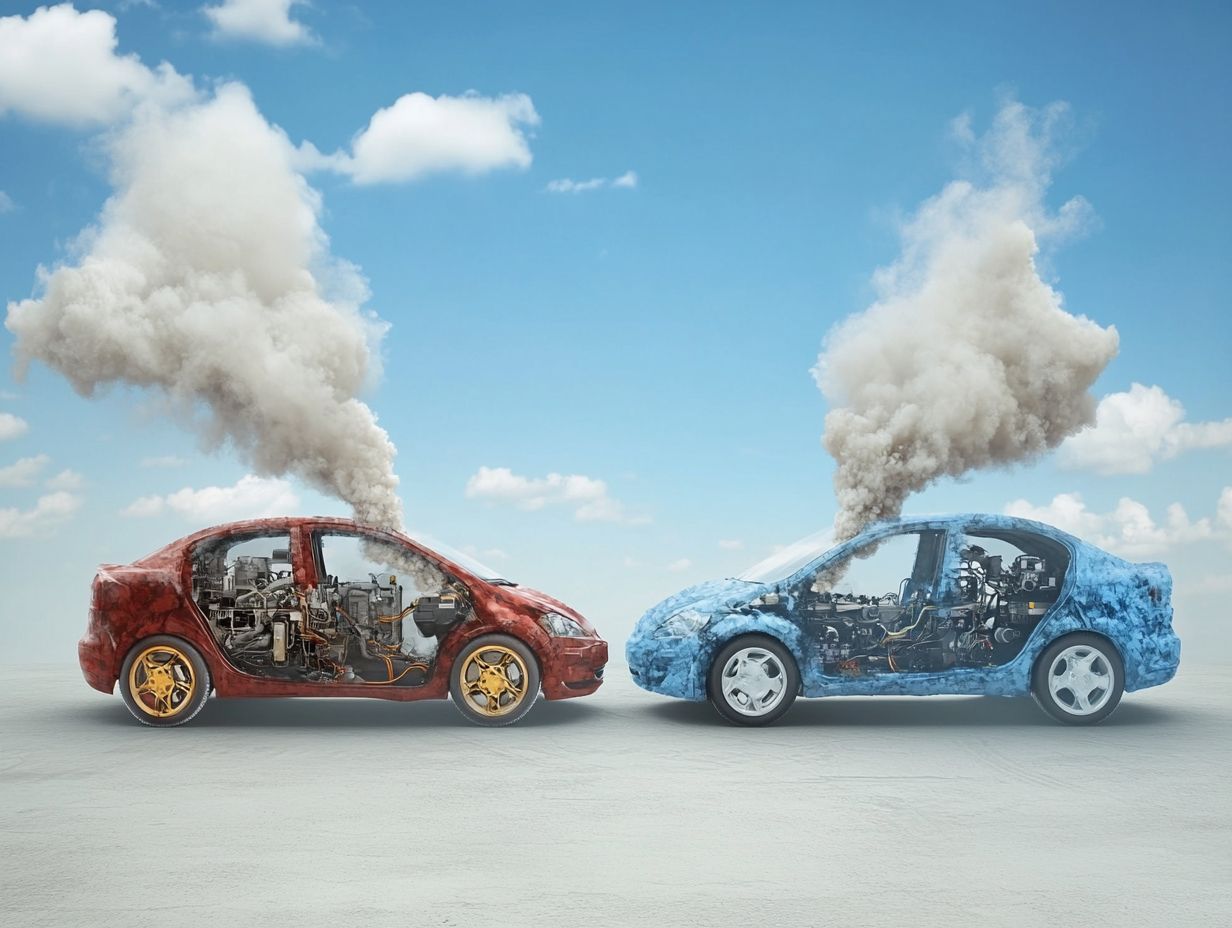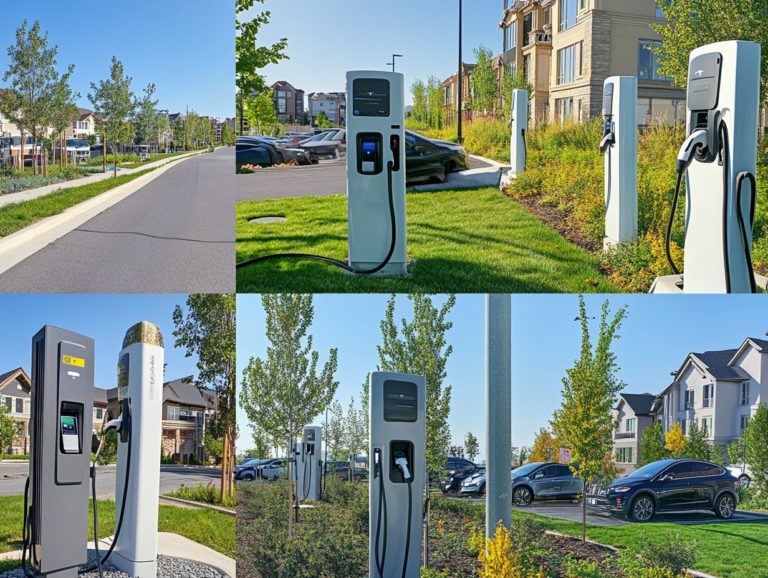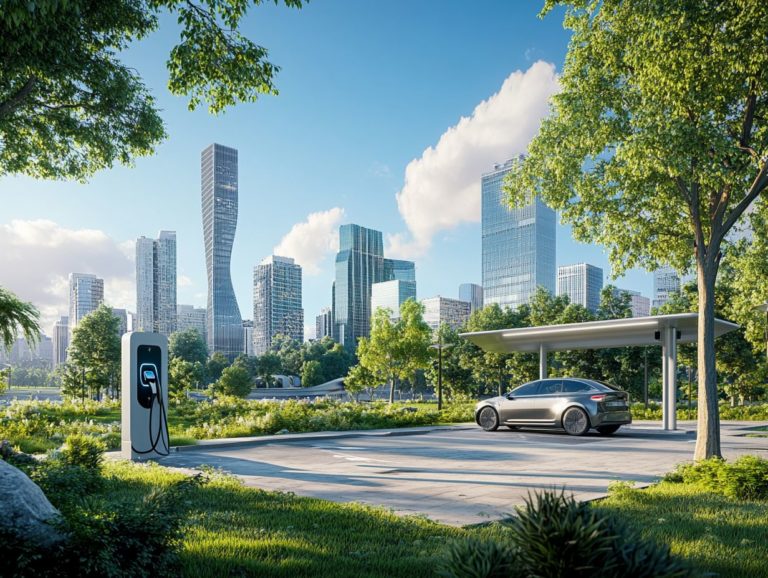Do Electric Vehicles Have Emissions?
Electric vehicles (EVs) are frequently celebrated as the eco-friendly alternative to traditional gasoline-powered cars, yet the truth about their environmental impact is far more intricate.
In this exploration, you ll delve into the definition and various types of EVs, assessing the emissions they generate in comparison to conventional vehicles. Key factors such as the sources of electricity and individual driving habits that affect emissions will be scrutinized, alongside the environmental benefits and potential drawbacks.
You ll also consider the future of EV technology and the policy changes that may arise, uncovering the complexities surrounding electric vehicles and their significant role in achieving a sustainable future.
Contents
- Key Takeaways:
- Overview of Electric Vehicles
- Emissions from Electric Vehicles
- Factors Affecting Emissions
- Environmental Impact of Electric Vehicles
- Future of Electric Vehicles
- Frequently Asked Questions
- Do Electric Vehicles Have Emissions?
- What are emissions?
- How do electric vehicles differ from traditional vehicles in terms of emissions?
- Do electric vehicles contribute to air pollution?
- Are electric vehicles completely emission-free?
- Are there any benefits to choosing an electric vehicle over a traditional vehicle in terms of emissions?
Key Takeaways:

- Electric vehicles do have emissions, but they are significantly lower than gasoline vehicles. The type of emissions and their impact on the environment vary depending on the source of electricity and driving habits.
- Factors such as renewable electricity sources and eco-friendly driving habits can greatly reduce emissions from electric vehicles. It is important to consider these factors when evaluating the environmental impact of electric vehicles.
- Electric vehicles have a promising future with advancements in technology and policy changes to support their widespread adoption. As the world shifts towards sustainable transportation, electric vehicles have the potential to greatly reduce greenhouse gas emissions and improve air quality.
Overview of Electric Vehicles
Electric vehicles (EVs) signify a transformative shift in the automotive landscape, emphasizing sustainability by dramatically reducing greenhouse gases and carbon footprint in comparison to traditional gasoline cars.
By harnessing renewable energy sources, EVs not only play a vital role in improving air quality but also foster new technologies, such as advanced battery manufacturing and systems that allow electric cars to send power back to the grid. These innovations enhance the capabilities of the power grid.
Definition and Types of Electric Vehicles
Electric vehicles can be understood as automobiles powered entirely or partially by electricity, with Battery Electric Vehicles (BEVs) and Plug-in Hybrid Electric Vehicles (PHEVs) representing the most common types. These vehicles stand in stark contrast to traditional gasoline cars.
The operational mechanisms of these vehicles showcase their innovative designs. BEVs rely exclusively on electric power stored in modern rechargeable batteries, delivering zero tailpipe emissions and enhanced efficiency when compared to conventional combustion engines. On the other hand, PHEVs combine an electric motor with a gasoline engine, offering greater flexibility and alleviating range anxiety.
These battery technologies not only improve energy storage capacity but also reduce environmental impact, positioning them as vital components in the pursuit of sustainable transportation solutions. When you compare fuel consumption and emissions, it becomes clear that both BEVs and PHEVs significantly outshine gasoline vehicles, paving the way for a cleaner, greener future.
Emissions from Electric Vehicles
Understanding emissions from electric vehicles is crucial in assessing their environmental impact. With zero tailpipe emissions, they drastically cut down greenhouse gas emissions when compared to traditional gasoline vehicles. This effect is even more pronounced when these vehicles are charged with clean energy sources, which further diminishes emissions intensity and carbon pollution.
Embracing electric vehicles not only contributes to a cleaner environment but also represents a meaningful step towards sustainability. Act now to be part of the clean energy revolution!
Comparing Emissions to Gasoline Vehicles

When you compare emissions from electric vehicles to those of gasoline cars, it becomes clear that EVs, especially those boasting a long electric range, tend to produce lower carbon dioxide (CO2) emissions particularly when you factor in the emissions intensity of the electricity used for charging.
This trend is strongly backed by case studies that highlight the significant differences in life-cycle emissions between these two vehicle types. For example, a study from the University of California demonstrated that electric vehicles can generate up to 50% fewer emissions than their gasoline counterparts. This is particularly true if the energy grid is clean.
Government regulations and strict vehicle safety standards also play a crucial role in ensuring compliance. They pave the way for emissions reductions throughout the automotive industry.
Programs that promote incentives for electric vehicle adoption enhance this cleaner automotive landscape, ultimately influencing your choices as a consumer and shaping market trends.
Factors Affecting Emissions
Several factors influence the emissions produced by electric vehicles, including the source of electricity used for charging, your driving habits, and the overall energy mix of the power grid. Each of these elements plays a crucial role in determining the true environmental benefits of EVs.
Understanding this relationship can help you make more informed decisions about your vehicle’s impact on the planet.
Source of Electricity and Driving Habits
The source of your electricity, whether it originates from renewable energy or fossil fuels, shapes the emissions profile of your electric vehicle. Your driving habits such as acceleration patterns and how often you charge also significantly influence the efficiency and performance of your EV s battery.
Consider California: its commitment to renewable energy has significantly reduced EV emissions, thanks to many charging stations powered by solar or wind energy. In contrast, in West Virginia, where coal still reigns supreme as the primary electricity source, the benefits of driving an electric vehicle may be reduced by the higher carbon emissions from the power grid.
By adopting smoother acceleration techniques and efficient charging routines, you enhance your battery life and lower your energy consumption. Emerging vehicle-to-grid technologies offer an exciting opportunity, allowing your EV to send stored energy back to the power supply during peak demand. This enhances grid stability and contributes to further reductions in overall emissions.
This interconnected approach shows how your choices and the power source can lead to a cleaner future.
Environmental Impact of Electric Vehicles
The environmental impact of electric vehicles extends beyond their day-to-day operation. It includes critical factors like battery manufacturing and the significant reduction of greenhouse gases. Together, these elements pave the way for a more sustainable future in transportation.
However, it’s important to acknowledge the challenges linked to resource extraction for battery components that accompany this transition.
Benefits and Drawbacks

Electric vehicles present a wealth of advantages, including diminished greenhouse gas emissions and lower operational costs. However, challenges associated with battery manufacturing and resource sourcing must also be considered to enhance their positive environmental impact.
These vehicles play a pivotal role in promoting cleaner air in urban environments by significantly reducing tailpipe emissions. This ultimately benefits public health. Over time, you might enjoy considerable savings on fuel and maintenance compared to traditional gasoline vehicles.
Experts emphasize the environmental costs linked to battery production, especially concerning the extraction of lithium, cobalt, and nickel. These processes can adversely affect ecosystems and local communities. It s essential to establish sustainable supply chains (responsibly sourcing materials without harming the environment) to ensure materials are sourced responsibly.
As the shift toward electric vehicles progresses, balancing these benefits with a commitment to green manufacturing practices is vital for achieving genuine sustainability.
Future of Electric Vehicles
Get ready! The future of electric vehicles is incredibly bright and full of potential, defined by rapid technology improvements and favorable policy shifts. Initiatives such as the Bipartisan Infrastructure Law are set to boost charging station availability and refine electric vehicle batteries. This will revolutionize the automotive landscape for your benefit.
Technological Advancements and Policy Changes
Technological advancements in electric vehicles, particularly in battery performance and the expansion of charging infrastructure, along with significant policy changes, are creating an environment ripe for greater adoption and enhanced vehicle safety standards in the EV market.
You ll find that higher energy density batteries are leading this charge, delivering longer ranges and quicker recharges that elevate your overall driving experience. Automated charging systems are making it easier for you to access power sources, further encouraging your shift towards electric mobility.
These innovations are accompanied by new regulations ensuring that manufacturers adhere to Federal Motor Vehicle Safety Standards. These regulations aim to enhance safety measures and inspire innovation in the industry. As these policies evolve, they re likely to create a more secure environment for you, instilling confidence in your choice of electric vehicles.
Frequently Asked Questions
Do Electric Vehicles Have Emissions?

No, electric vehicles do not have emissions because they do not use internal combustion engines.
What are emissions?
Emissions refer to the release of pollutants into the environment, usually from burning fossil fuels.
How do electric vehicles differ from traditional vehicles in terms of emissions?
Electric vehicles are powered by batteries, while traditional vehicles use gasoline or diesel, which emit pollutants into the air.
Do electric vehicles contribute to air pollution?
No, electric vehicles do not contribute to air pollution as they do not emit any pollutants during operation.
Are electric vehicles completely emission-free?
While electric vehicles do not emit pollutants during operation, it’s important to consider how electric cars impact air quality, as some manufacturing processes used to create them may still produce emissions.
Are there any benefits to choosing an electric vehicle over a traditional vehicle in terms of emissions?
Yes, electric vehicles produce lower emissions overall, which can help reduce air pollution and combat climate change.






